Vegetation Disturbance and Recovery Dynamics of Different Surface Mining Sites via the LandTrendr Algorithm: Case Study in Inner Mongolia, China
Abstract
:1. Introduction
2. Materials and Methods
2.1. Study Area
2.2. Data Acquisition and Preprocessing
2.3. Description of Different Patterns for the Two Mining Sites
2.4. Ecological Impacts Monitoring of Surface Mining Sites
2.4.1. Vegetation Disturbance and Recovery Conceptual Model in Surface Mining Site
2.4.2. Vegetation Disturbance and Recovery Detection by the LandTrendr Algorithm
2.5. Accuracy Assessment and Validation
3. Results
3.1. Patterns of the Two Mining Sites
3.2. Accuracy Assessment of Disturbance and Recovery Identification
3.3. Spatiotemporal Characteristics of Vegetation Disturbance and Recovery
3.3.1. The Occurrence Year of Vegetation Disturbance and Recovery
3.3.2. The Duration of Vegetation Disturbance and Recovery
3.3.3. The Magnitude of Vegetation Disturbance and Recovery
3.4. Ecological Impacts under Different Mining Patterns and Surrounding Environments
4. Discussion
4.1. Assessing Surface Mining Site Disturbance and Recovery
4.2. Comparison of the Two Mining Sites
4.3. Research Limitations and Future Work
5. Conclusions
Author Contributions
Funding
Acknowledgments
Conflicts of Interest
Appendix A
| Year | Recovery | Disturbance | Cumulative Recovery | Cumulative Disturbance | Cumulative R/D Ratio |
|---|---|---|---|---|---|
| 1987 | 5100 | 10,995 | n/a | n/a | n/a |
| 1988 | 43 | 92 | 43 | 92 | 46.74% |
| 1989 | 20 | 139 | 63 | 231 | 27.27% |
| 1990 | 62 | 20 | 125 | 251 | 49.80% |
| 1991 | 61 | 36 | 186 | 287 | 64.81% |
| 1992 | 8 | 214 | 194 | 501 | 38.72% |
| 1993 | 7 | 1771 | 201 | 2272 | 8.85% |
| 1994 | 50 | 627 | 251 | 2899 | 8.66% |
| 1995 | 19 | 6851 | 270 | 9750 | 2.77% |
| 1996 | 19 | 2552 | 289 | 12,302 | 2.35% |
| 1997 | 11 | 1246 | 300 | 13,548 | 2.21% |
| 1998 | 112 | 838 | 412 | 14,386 | 2.86% |
| 1999 | 11 | 2335 | 423 | 16,721 | 2.53% |
| 2000 | 52 | 289 | 475 | 17,010 | 2.79% |
| 2001 | 135 | 509 | 610 | 17,519 | 3.48% |
| 2002 | 306 | 211 | 916 | 17,730 | 5.17% |
| 2003 | 99 | 6010 | 1015 | 23,740 | 4.28% |
| 2004 | 1109 | 233 | 2124 | 23,973 | 8.86% |
| 2005 | 283 | 151 | 2407 | 24,124 | 9.98% |
| 2006 | 276 | 78 | 2683 | 24,202 | 11.09% |
| 2007 | 360 | 551 | 3043 | 24,753 | 12.29% |
| 2008 | 393 | 2029 | 3436 | 26,782 | 12.83% |
| 2009 | 849 | 597 | 4285 | 27,379 | 15.65% |
| 2010 | 442 | 478 | 4727 | 27,857 | 16.97% |
| 2011 | 397 | 603 | 5124 | 28,460 | 18.00% |
| 2012 | 944 | 154 | 6068 | 28,614 | 21.21% |
| 2013 | 1091 | 269 | 7159 | 28,883 | 24.79% |
| 2014 | 367 | 523 | 7526 | 29,406 | 25.59% |
| 2015 | 355 | 538 | 7881 | 29,944 | 26.32% |
| 2016 | 412 | 539 | 8293 | 30,483 | 27.21% |
| 2017 | 488 | 450 | 8781 | 30,933 | 28.39% |
| 2018 | 65 | 519 | 8846 | 31,452 | 28.13% |
| 2019 | 4 | 1481 | 8850 | 32,933 | 26.87% |
| 2020 | 0 | 1423 | 8850 | 34,356 | 25.76% |
| Year | Recovery | Disturbance | Cumulative Recovery | Cumulative Disturbance | Cumulative R/D Ratio |
|---|---|---|---|---|---|
| 1987 | 32,272 | 49,650 | n/a | n/a | n/a |
| 1988 | 27 | 13 | 27 | 13 | 207.69% |
| 1989 | 1649 | 8517 | 1676 | 8530 | 19.65% |
| 1990 | 187 | 54 | 1863 | 8584 | 21.70% |
| 1991 | 63 | 129 | 1926 | 8713 | 22.10% |
| 1992 | 43 | 2383 | 1969 | 11,096 | 17.75% |
| 1993 | 65 | 6122 | 2034 | 17,218 | 11.81% |
| 1994 | 215 | 2271 | 2249 | 19,489 | 11.54% |
| 1995 | 81 | 6170 | 2330 | 25,659 | 9.08% |
| 1996 | 130 | 10,447 | 2460 | 36,106 | 6.81% |
| 1997 | 87 | 14,023 | 2547 | 50,129 | 5.08% |
| 1998 | 513 | 911 | 3060 | 51,040 | 6.00% |
| 1999 | 107 | 3234 | 3167 | 54,274 | 5.84% |
| 2000 | 103 | 1661 | 3270 | 55,935 | 5.85% |
| 2001 | 333 | 3738 | 3603 | 59,673 | 6.04% |
| 2002 | 2107 | 1223 | 5710 | 60,896 | 9.38% |
| 2003 | 1118 | 13,702 | 6828 | 74,598 | 9.15% |
| 2004 | 1754 | 1728 | 8582 | 76,326 | 11.24% |
| 2005 | 1712 | 2501 | 10,294 | 78,827 | 13.06% |
| 2006 | 1324 | 1007 | 11,618 | 79,834 | 14.55% |
| 2007 | 2711 | 2995 | 14,329 | 82,829 | 17.30% |
| 2008 | 1621 | 21,686 | 15,950 | 104,515 | 15.26% |
| 2009 | 3343 | 4356 | 19,293 | 108,871 | 17.72% |
| 2010 | 1959 | 4969 | 21,252 | 113,840 | 18.67% |
| 2011 | 1458 | 7146 | 22,710 | 120,986 | 18.77% |
| 2012 | 5608 | 1583 | 28,318 | 122,569 | 23.10% |
| 2013 | 3706 | 2676 | 32,024 | 125,245 | 25.57% |
| 2014 | 2280 | 2971 | 34,304 | 128,216 | 26.75% |
| 2015 | 1344 | 4035 | 35,648 | 132,251 | 26.95% |
| 2016 | 2276 | 2388 | 37,924 | 134,639 | 28.17% |
| 2017 | 2546 | 4970 | 40,470 | 139,609 | 28.99% |
| 2018 | 842 | 2453 | 41,312 | 142,062 | 29.08% |
| 2019 | 82 | 3602 | 41,394 | 145,664 | 28.42% |
| 2020 | 0 | 4398 | 41,394 | 150,062 | 27.58% |
References
- Xiao, W.; Lv, X.J.; Zhao, Y.L.; Sun, H.X.; Li, J.Q. Ecological resilience assessment of an arid coal mining area using index of entropy and linear weighted analysis: A case study of Shendong Coalfield, China. Ecol. Indic. 2020, 109, 105843. [Google Scholar] [CrossRef]
- Lv, X.J.; Xiao, W.; Zhao, Y.L.; Zhang, W.K.; Li, S.C.; Sun, H.X. Drivers of spatio-temporal ecological vulnerability in an arid, coal mining region in Western China. Ecol. Indic. 2019, 106, 105475. [Google Scholar] [CrossRef]
- Hodge, R.A. Mining company performance and community conflict: Moving beyond a seeming paradox. J. Clean. Prod. 2014, 84, 27–33. [Google Scholar] [CrossRef]
- Dong, S.G.; Feng, H.B.; Xia, M.H.; Li, Y.; Wang, C.; Wang, L. Spatial-temporal evolutions of groundwater environment in prairie opencast coal mine area: A case study of Yimin Coal Mine, China. Environ. Geochem. Health 2020, 42, 3101–3118. [Google Scholar] [CrossRef] [PubMed]
- Pericak, A.A.; Thomas, C.J.; Kroodsma, D.A.; Wasson, M.F.; Ross, M.R.V.; Clinton, N.E.; Campagna, D.J.; Franklin, Y.; Bernhardt, E.S.; Amos, J.F. Mapping the yearly extent of surface coal mining in Central Appalachia using Landsat and Google Earth Engine. PLoS ONE 2018, 13, e0197758. [Google Scholar] [CrossRef] [Green Version]
- Lechner, A.M.; McIntyre, N.; Witt, K.; Raymond, C.M.; Arnold, S.; Scott, M.; Rifldn, W. Challenges of integrated modelling in mining regions to address social, environmental and economic impacts. Environ. Model. Softw. 2017, 93, 268–281. [Google Scholar] [CrossRef]
- Xiao, W.; Deng, X.Y.; He, T.T.; Chen, W.Q. Mapping Annual Land Disturbance and Reclamation in a Surface Coal Mining Region Using Google Earth Engine and the LandTrendr Algorithm: A Case Study of the Shengli Coalfield in Inner Mongolia, China. Remote Sens. 2020, 12, 1612. [Google Scholar] [CrossRef]
- Bao, N.S.; Lechner, A.; Fletcher, A.; Erskine, P.; Mulligan, D.; Bai, Z.K. SPOTing long-term changes in vegetation over short-term variability. Int. J. Min. Reclam. Environ. 2014, 28, 2–24. [Google Scholar] [CrossRef]
- Li, X.J.; Chen, W.T.; Cheng, X.W.; Wang, L.Z. A Comparison of Machine Learning Algorithms for Mapping of Complex Surface-Mined and Agricultural Landscapes Using ZiYuan-3 Stereo Satellite Imagery. Remote Sens. 2016, 8, 514. [Google Scholar] [CrossRef] [Green Version]
- Chen, W.T.; Li, X.J.; He, H.X.; Wang, L.Z. Assessing Different Feature Sets’ Effects on Land Cover Classification in Complex Surface-Mined Landscapes by ZiYuan-3 Satellite Imagery. Remote Sens. 2018, 10, 23. [Google Scholar] [CrossRef] [Green Version]
- Sonter, L.J.; Moran, C.J.; Barrett, D.J.; Soares, B.S. Processes of land use change in mining regions. J. Clean. Prod. 2014, 84, 494–501. [Google Scholar] [CrossRef] [Green Version]
- Yang, Z.; Li, J.; Zipper, C.E.; Shen, Y.Y.; Miao, H.; Donovan, P.F. Identification of the disturbance and trajectory types in mining areas using multitemporal remote sensing images. Sci. Total Environ. 2018, 644, 916–927. [Google Scholar] [CrossRef]
- Gypser, S.; Herppich, W.B.; Fischer, T.; Lange, P.; Veste, M. Photosynthetic characteristics and their spatial variance on biological soil crusts covering initial soils of post-mining sites in Lower Lusatia, NE Germany. Flora 2016, 220, 103–116. [Google Scholar] [CrossRef]
- Kennedy, R.E.; Yang, Z.Q.; Cohen, W.B.; Pfaff, E.; Braaten, J.; Nelson, P. Spatial and temporal patterns of forest disturbance and regrowth within the area of the Northwest Forest Plan. Remote Sens. Environ. 2012, 122, 117–133. [Google Scholar] [CrossRef]
- Kennedy, R.E.; Yang, Z.G.; Cohen, W.B. Detecting trends in forest disturbance and recovery using yearly Landsat time series: 1. LandTrendr—Temporal segmentation algorithms. Remote Sens. Environ. 2010, 114, 2897–2910. [Google Scholar] [CrossRef]
- Verbesselt, J.; Hyndman, R.; Newnham, G.; Culvenor, D. Detecting trend and seasonal changes in satellite image time series. Remote Sens. Environ. 2010, 114, 106–115. [Google Scholar] [CrossRef]
- Verbesselt, J.; Hyndman, R.; Zeileis, A.; Culvenor, D. Phenological change detection while accounting for abrupt and gradual trends in satellite image time series. Remote Sens. Environ. 2010, 114, 2970–2980. [Google Scholar] [CrossRef] [Green Version]
- Zhu, Z.; Woodcock, C.E. Continuous change detection and classification of land cover using all available Landsat data. Remote Sens. Environ. 2014, 144, 152–171. [Google Scholar] [CrossRef] [Green Version]
- Liu, S.S.; Wei, X.L.; Li, D.Q.; Lu, D.S. Examining Forest Disturbance and Recovery in the Subtropical Forest Region of Zhejiang Province Using Landsat Time-Series Data. Remote Sens. 2017, 9, 479. [Google Scholar] [CrossRef] [Green Version]
- Cohen, W.B.; Yang, Z.Q.; Heale, S.P.; Kennedy, R.E.; Gorelic, N. A LandTrendr multispectral ensemble for forest disturbance detection. Remote Sens. Environ. 2018, 205, 131–140. [Google Scholar] [CrossRef]
- Zou, Z.H.; Xiao, X.M.; Dong, J.W.; Qin, Y.W.; Doughty, R.B.; Menarguez, M.A.; Zhang, G.L.; Wang, J. Divergent trends of open-surface water body area in the contiguous United States from 1984 to 2016. Proc. Natl. Acad. Sci. USA 2018, 115, 3810–3815. [Google Scholar] [CrossRef] [Green Version]
- He, T.T.; Xiao, W.; Zhao, Y.L.; Deng, X.Y.; Hu, Z.Q. Identification of waterlogging in Eastern China induced by mining subsidence: A case study of Google Earth Engine time-series analysis applied to the Huainan coal field. Remote Sens. Environ. 2020, 242, 111742. [Google Scholar] [CrossRef]
- Cohen, W.B.; Yang, Z.G.; Kennedy, R. Detecting trends in forest disturbance and recovery using yearly Landsat time series: 2. TimeSync—Tools for calibration and validation. Remote Sens. Environ. 2010, 114, 2911–2924. [Google Scholar] [CrossRef]
- Yang, Y.J.; Erskine, P.D.; Lechner, A.M.; Mulligan, D.; Zhang, S.L.; Wang, Z.Y. Detecting the dynamics of vegetation disturbance and recovery in surface mining area via Landsat imagery and LandTrendr algorithm. J. Clean. Prod. 2018, 178, 353–362. [Google Scholar] [CrossRef]
- Yaylaci, E.D.; Duzgun, H.S. Evaluating the mine plan alternatives with respect to bottom-up and top-down sustainability criteria. J. Clean. Prod. 2017, 167, 837–849. [Google Scholar] [CrossRef]
- Marnika, E.; Christodoulou, E.; Xenidis, A. Sustainable development indicators for mining sites in protected areas: Tool development, ranking and scoring of potential environmental impacts and assessment of management scenarios. J. Clean. Prod. 2015, 101, 59–70. [Google Scholar] [CrossRef]
- Kennedy, R.E.; Yang, Z.Q.; Gorelick, N.; Braaten, J.; Cavalcante, L.; Cohen, W.B.; Healey, S. Implementation of the LandTrendr Algorithm on Google Earth Engine. Remote Sens. 2018, 10, 691. [Google Scholar] [CrossRef] [Green Version]
- Gorelick, N.; Hancher, M.; Dixon, M.; Ilyushchenko, S.; Thau, D.; Moore, R. Google Earth Engine: Planetary-scale geospatial analysis for everyone. Remote Sens. Environ. 2017, 202, 18–27. [Google Scholar] [CrossRef]
- Li, H.T.; Xie, M.M.; Wang, H.H.; Li, S.L.; Xu, M. Spatial Heterogeneity of Vegetation Response to Mining Activities in Resource Regions of Northwestern China. Remote Sens. 2020, 12, 3247. [Google Scholar] [CrossRef]
- Zeng, Q.; Shen, L.; Yang, J. Potential impacts of mining of super-thick coal seam on the local environment in arid Eastern Junggar coalfield, Xinjiang region, China. Environ. Earth Sci. 2020, 79, 88. [Google Scholar] [CrossRef]
- Qian, D.W.; Yan, C.Z.; Xiu, L.N.; Feng, K. The impact of mining changes on surrounding lands and ecosystem service value in the Southern Slope of Qilian Mountains. Ecol. Complex. 2018, 36, 138–148. [Google Scholar] [CrossRef]
- Gong, C.G.; Lei, S.G.; Bian, Z.F.; Liu, Y.; Zhang, Z.; Cheng, W. Analysis of the Development of an Erosion Gully in an Open-Pit Coal Mine Dump During a Winter Freeze-Thaw Cycle by Using Low-Cost UAVs. Remote Sens. 2019, 11, 1356. [Google Scholar] [CrossRef] [Green Version]
- Zibret, G.; Gosar, M.; Miler, M.; Alijagic, J. Impacts of mining and smelting activities on environment and landscape degradation-Slovenian case studies. Land Degrad. Dev. 2018, 29, 4457–4470. [Google Scholar] [CrossRef] [Green Version]
- Jing, Z.R.; Wang, J.M.; Zhu, Y.C.; Feng, Y. Effects of land subsidence resulted from coal mining on soil nutrient distributions in a loess area of China. J. Clean. Prod. 2018, 177, 350–361. [Google Scholar] [CrossRef]
- Masek, J.G.; Vermote, E.F.; Saleous, N.E.; Wolfe, R.; Hall, F.G.; Huemmrich, K.F.; Gao, F.; Kutler, J.; Lim, T.K. A Landsat surface reflectance dataset for North America, 1990–2000. IEEE Geosci. Remote Sens. Lett. 2006, 3, 68–72. [Google Scholar] [CrossRef]
- Foga, S.; Scaramuzza, P.L.; Guo, S.; Zhu, Z.; Dilley, R.D.; Beckmann, T.; Schmidt, G.L.; Dwyer, J.L.; Hughes, M.J.; Laue, B. Cloud detection algorithm comparison and validation for operational Landsat data products. Remote Sens. Environ. 2017, 194, 379–390. [Google Scholar] [CrossRef] [Green Version]
- Wu, J.G.; Shen, W.J.; Sun, W.Z.; Tueller, P.T. Empirical patterns of the effects of changing scale on landscape metrics. Landsc. Ecol. 2002, 17, 761–782. [Google Scholar] [CrossRef]
- Gustafson, E.J. Quantifying landscape spatial pattern: What is the state of the art? Ecosystems 1998, 1, 143–156. [Google Scholar] [CrossRef]
- Brom, J.; Nedbal, V.; Prochazka, J.; Pecharova, E. Changes in vegetation cover, moisture properties and surface temperature of a brown coal dump from 1984 to 2009 using satellite data analysis. Ecol. Eng. 2012, 43, 45–52. [Google Scholar] [CrossRef]
- Liu, X.Y.; Zhou, W.; Bai, Z.K. Vegetation coverage change and stability in large open-pit coal mine dumps in China during 1990–2015. Ecol. Eng. 2016, 95, 447–451. [Google Scholar] [CrossRef]
- Han, Y.; Ke, Y.H.; Zhu, L.J.; Feng, H.; Zhang, Q.; Sun, Z.; Zhu, L. Tracking vegetation degradation and recovery in multiple mining areas in Beijing, China, based on time-series Landsat imagery. GiSci. Remote Sens. 2021, 58, 1477–1496. [Google Scholar] [CrossRef]
- Karan, S.K.; Samadder, S.R.; Maiti, S.K. Assessment of the capability of remote sensing and GIS techniques for monitoring reclamation success in coal mine degraded lands. J. Environ. Manag. 2016, 182, 272–283. [Google Scholar] [CrossRef]
- Foody, G.M. Status of land cover classification accuracy assessment. Remote Sens. Environ. 2002, 80, 185–201. [Google Scholar] [CrossRef]
- Congalton, R.G.; Green, K. A Practical Look at the Sources of Confusion in Error Matrix Generation. Photogramm. Eng. Remote Sens. 1993, 59, 641–644. [Google Scholar]
- Vintro, C.; Sanmiquel, L.; Freijo, M. Environmental sustainability in the mining sector: Evidence from Catalan companies. J. Clean. Prod. 2014, 84, 155–163. [Google Scholar] [CrossRef] [Green Version]
- Worrall, R.; Neil, D.; Brereton, D.; Mulligan, D. Towards a sustainability criteria and indicators framework for legacy mine land. J. Clean. Prod. 2009, 17, 1426–1434. [Google Scholar] [CrossRef]
- Long, T.F.; Zhang, Z.M.; He, G.J.; Jiao, W.L.; Tang, C.; Wu, B.F.; Zhang, X.M.; Wang, G.Z.; Yin, R.Y. 30 m Resolution Global Annual Burned Area Mapping Based on Landsat Images and Google Earth Engine. Remote Sens. 2019, 11, 489. [Google Scholar] [CrossRef] [Green Version]
- Dong, J.W.; Xiao, X.M.; Menarguez, M.A.; Zhang, G.L.; Qin, Y.W.; Thau, D.; Biradar, C.; Moore, B. Mapping paddy rice planting area in northeastern Asia with Landsat 8 images, phenology-based algorithm and Google Earth Engine. Remote Sens. Environ. 2016, 185, 142–154. [Google Scholar] [CrossRef] [PubMed] [Green Version]
- Franks, D.M.; Brereton, D.; Moran, C.J. The cumulative dimensions of impact in resource regions. Resour. Policy 2013, 38, 640–647. [Google Scholar] [CrossRef]
- Lechner, A.M.; Baumgartl, T.; Matthew, P.; Glenn, V. The Impact of Underground Longwall Mining on Prime Agricultural Land: A Review and Research Agenda. Land Degrad. Dev. 2016, 27, 1650–1663. [Google Scholar] [CrossRef]
- Gilland, K.E.; McCarthy, B.C. Microtopography Influences Early Successional Plant Communities on Experimental Coal Surface Mine Land Reclamation. Restor. Ecol. 2014, 22, 232–239. [Google Scholar] [CrossRef]
- Gonzalez-Alday, J.; Marrs, R.H.; Martinez-Ruiz, C. The influence of aspect on the early growth dynamics of hydroseeded species in coal reclamation areas. Appl. Veg. Sci. 2008, 11, 405–412. [Google Scholar] [CrossRef]
- Cao, Y.G.; Wang, J.M.; Bai, Z.K.; Zhou, W.; Zhao, Z.Q.; Ding, X.; Li, Y.N. Differentiation and mechanisms on physical properties of reconstructed soils on open-cast mine dump of loess area. Environ. Earth Sci. 2015, 74, 6367–6380. [Google Scholar] [CrossRef]
- Cizkova, B.; Wos, B.; Pietrzykowski, M.; Frouz, J. Development of soil chemical and microbial properties in reclaimed and unreclaimed grasslands in heaps after opencast lignite mining. Ecol. Eng. 2018, 123, 103–111. [Google Scholar] [CrossRef]
- Ezeokoli, O.T.; Mashigo, S.K.; Paterson, D.G.; Bezuidenhout, C.C.; Adeleke, R.A. Microbial community structure and relationship with physicochemical properties of soil stockpiles in selected South African opencast coal mines. Soil Sci. Plant Nutr. 2019, 65, 332–341. [Google Scholar] [CrossRef]
- Wang, J.M.; Wang, H.D.; Cao, Y.G.; Bai, Z.K.; Qin, Q. Effects of soil and topographic factors on vegetation restoration in opencast coal mine dumps located in a loess area. Sci. Rep. 2016, 6, 22058. [Google Scholar] [CrossRef] [Green Version]
- Gao, S.H.; He, R.X.; Jin, H.J.; Huang, Y.D.; Zhang, J.M.; Luo, D.L. Thermal recovery process of a backfilled open-pit in permafrost area at the Gulian strip coal mine in Northeast China. J. Mt. Sci. 2017, 14, 2212–2229. [Google Scholar] [CrossRef]
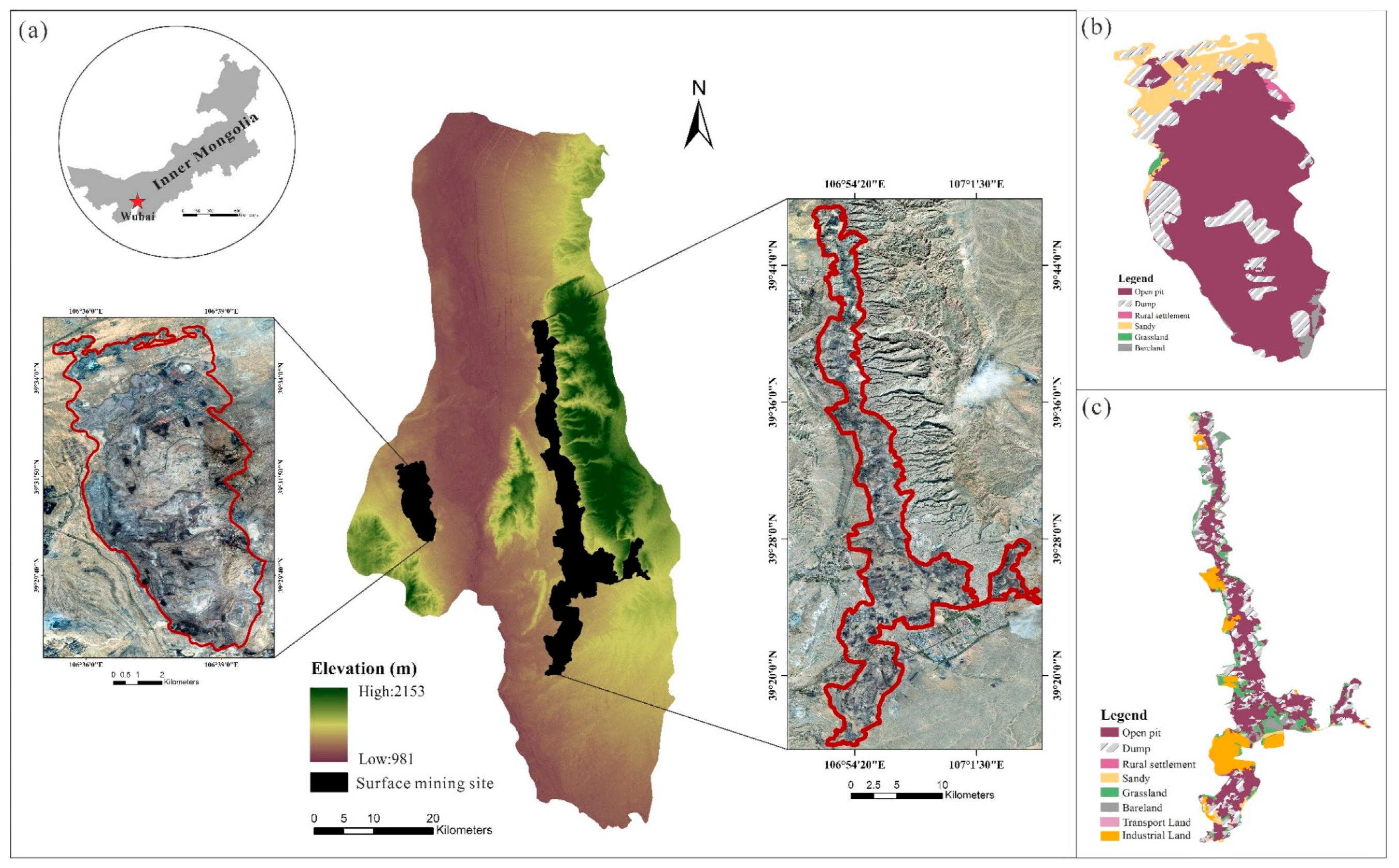
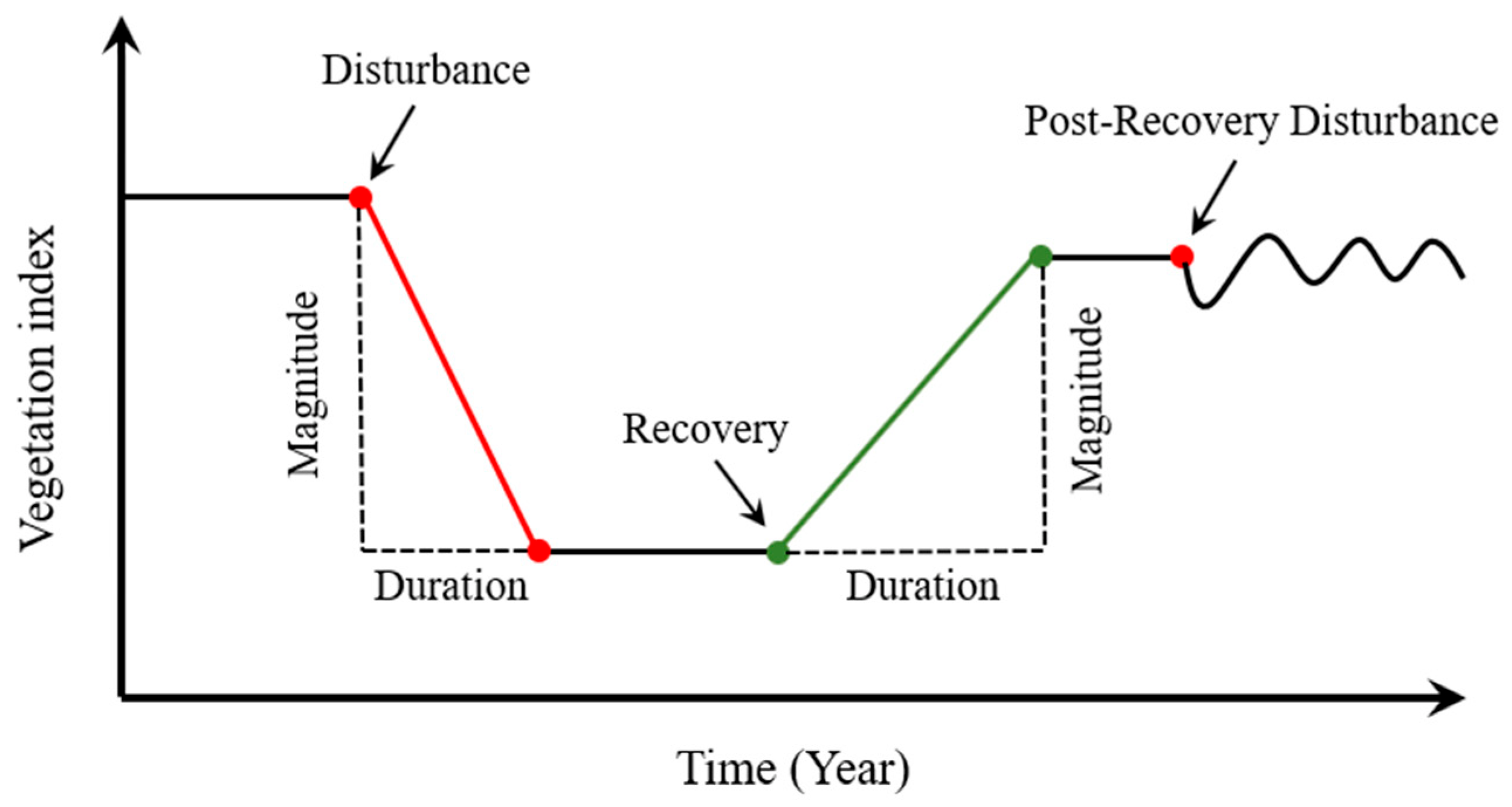

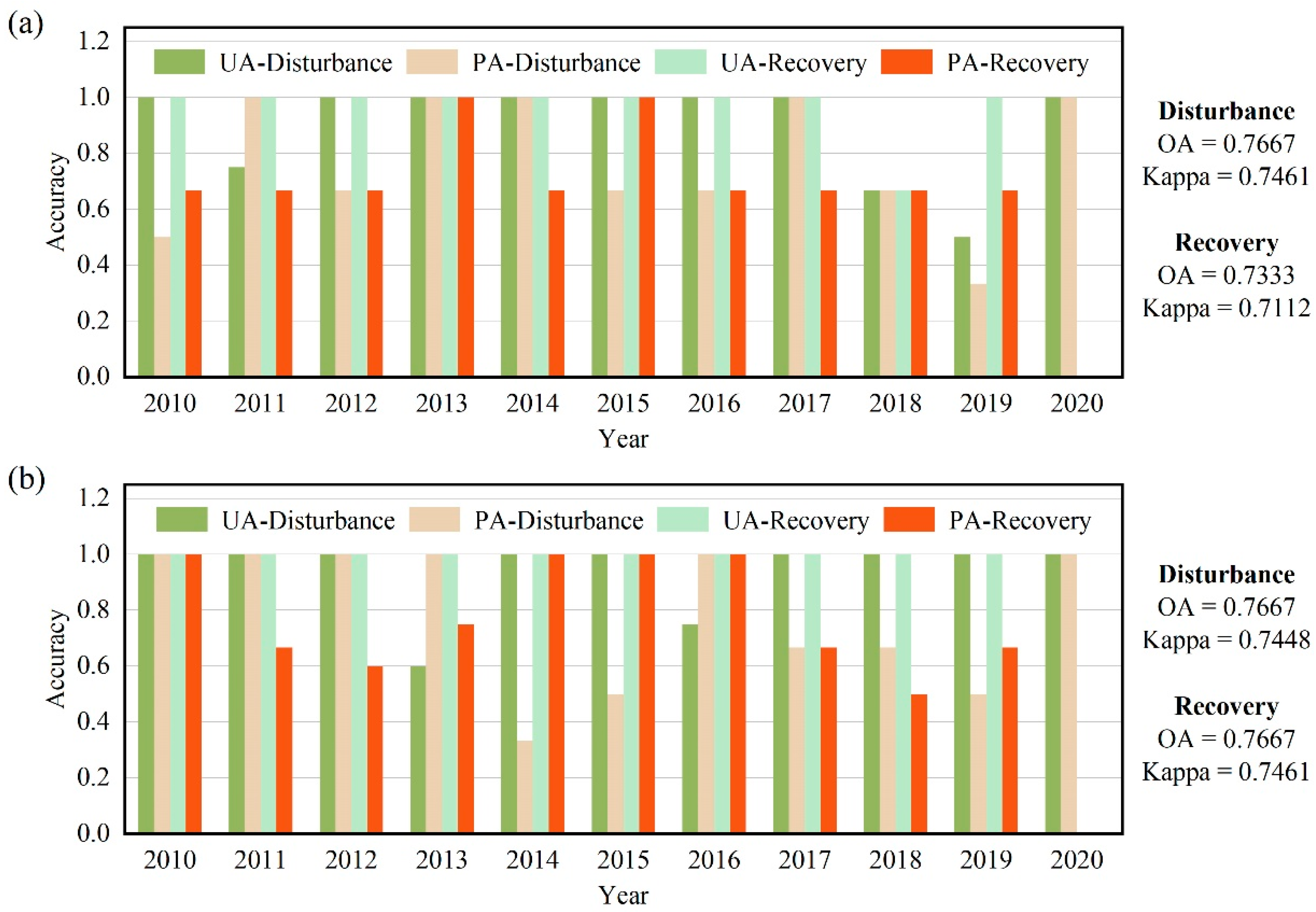
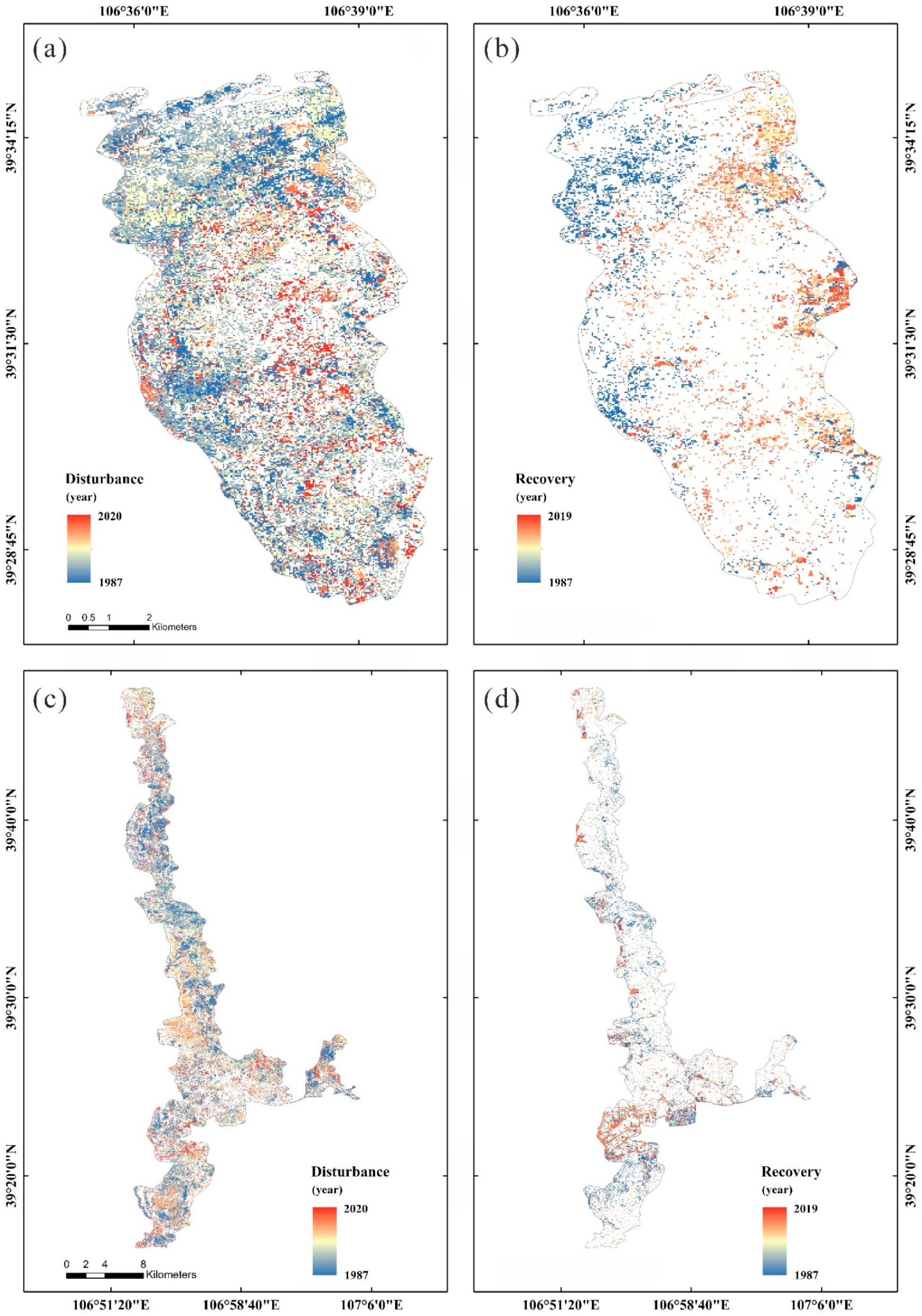
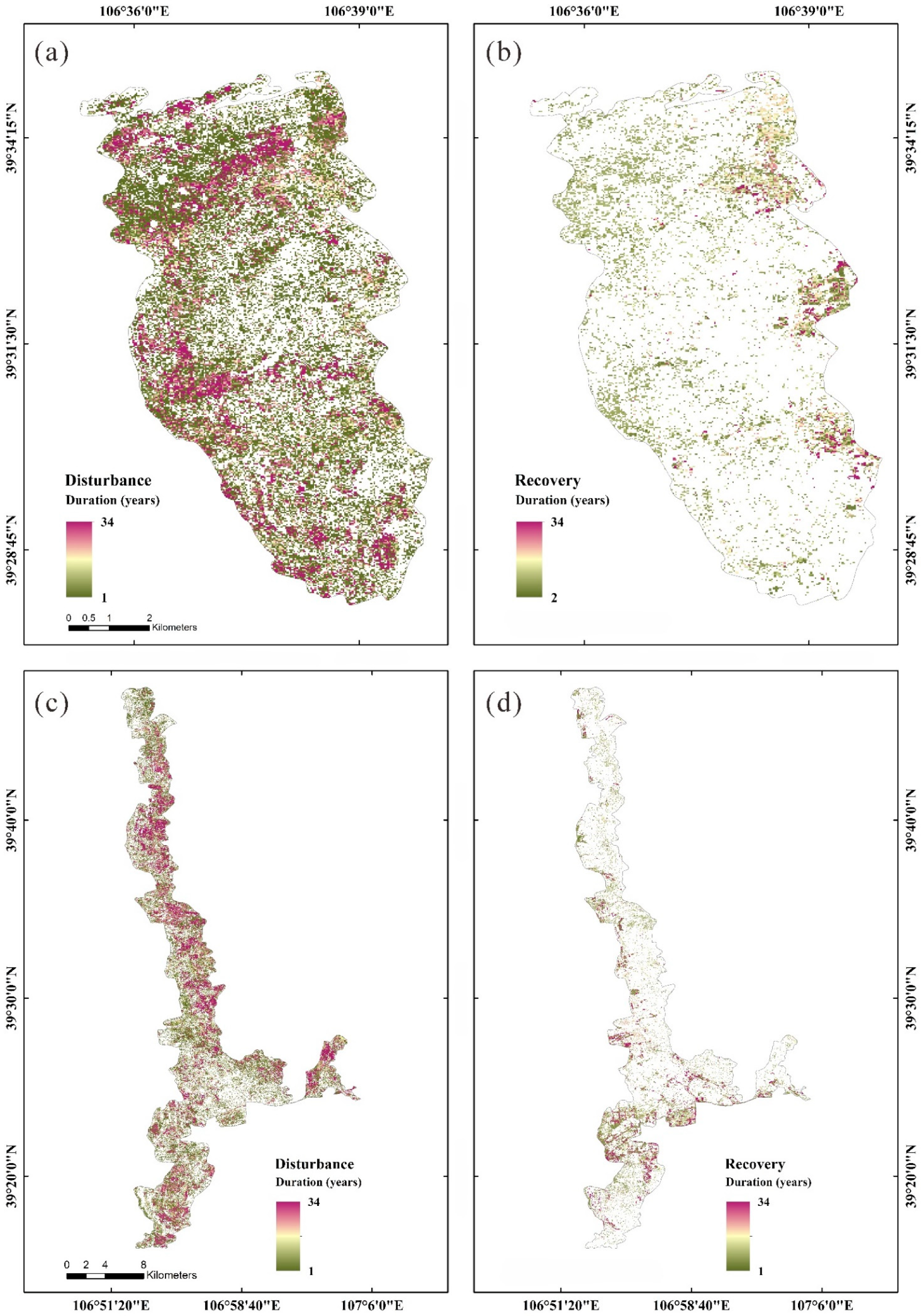
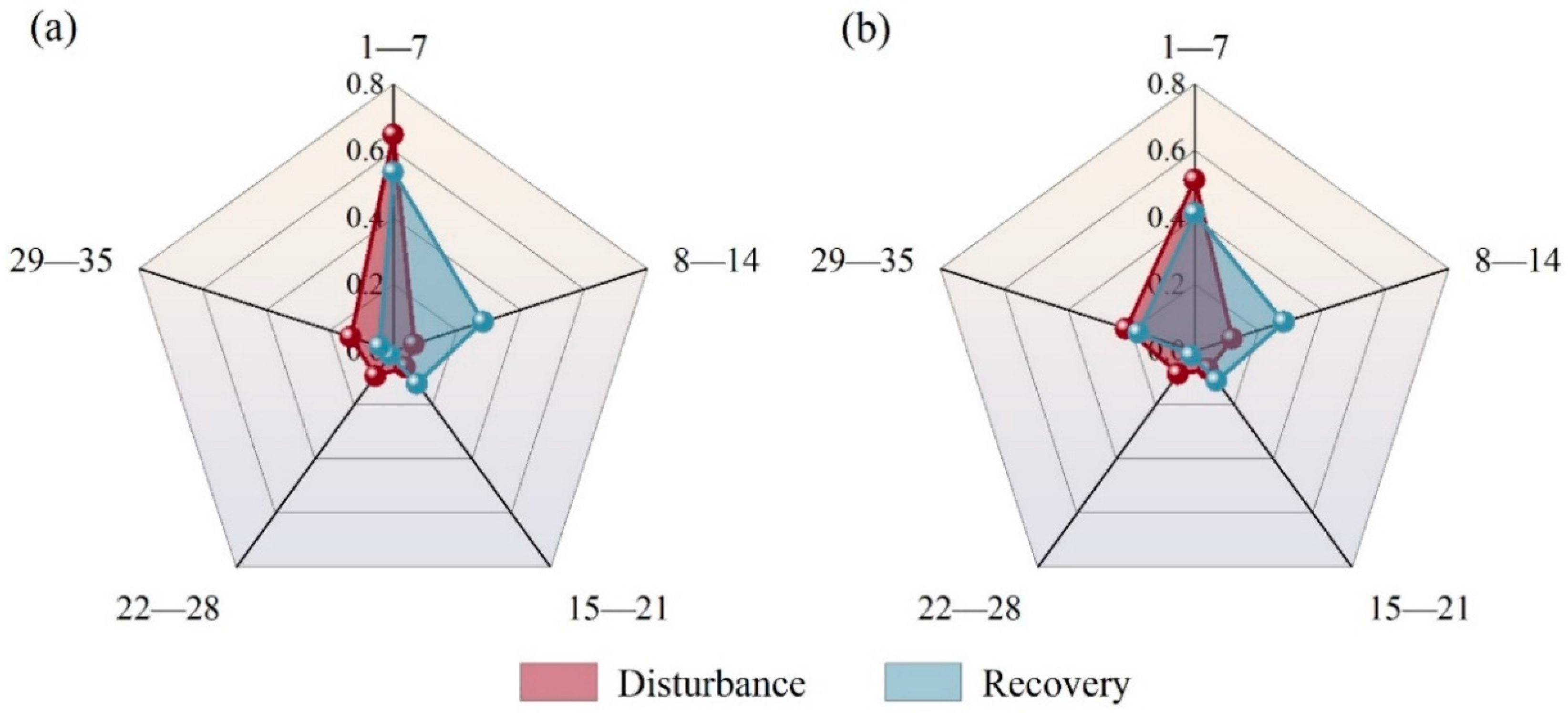
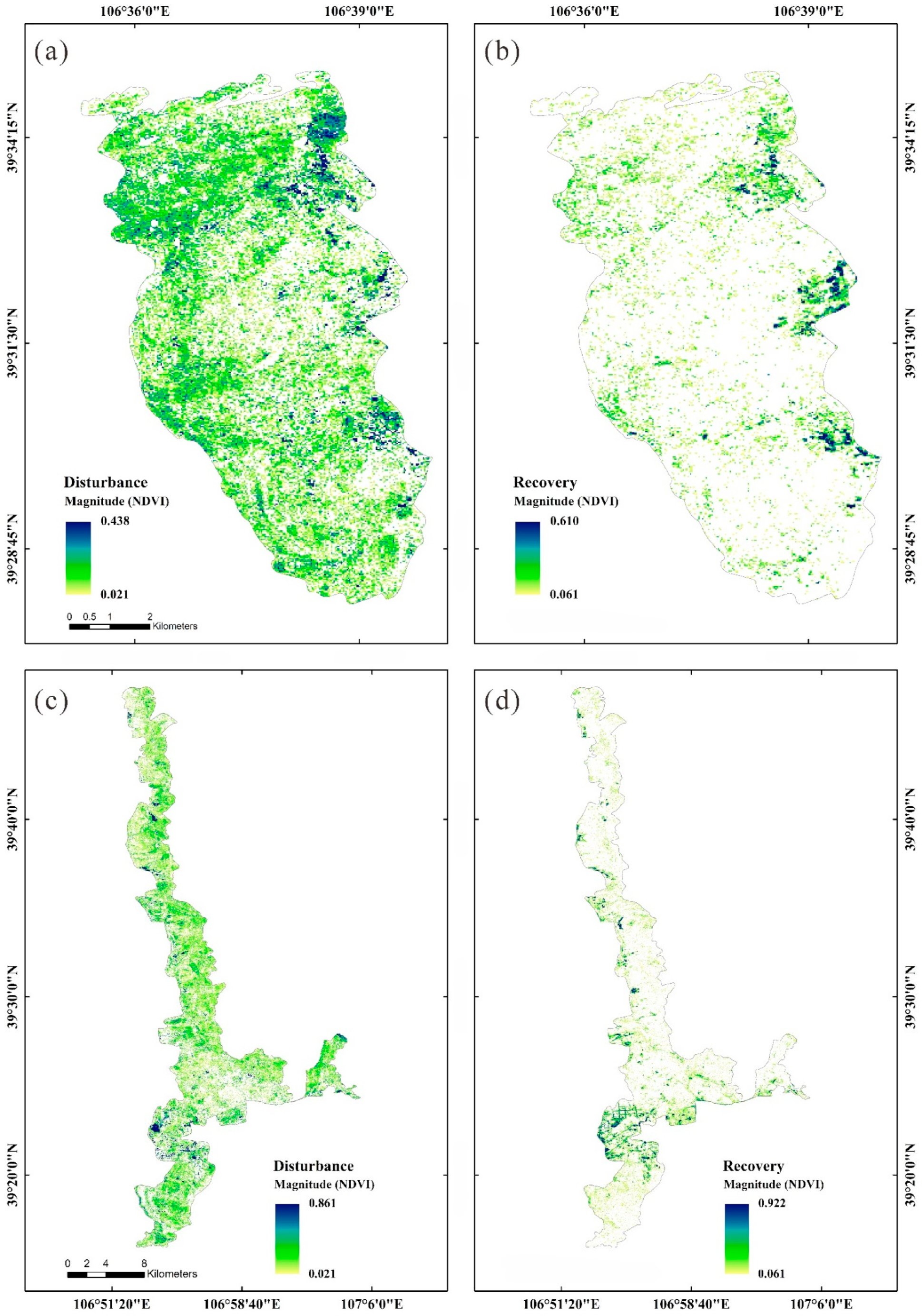
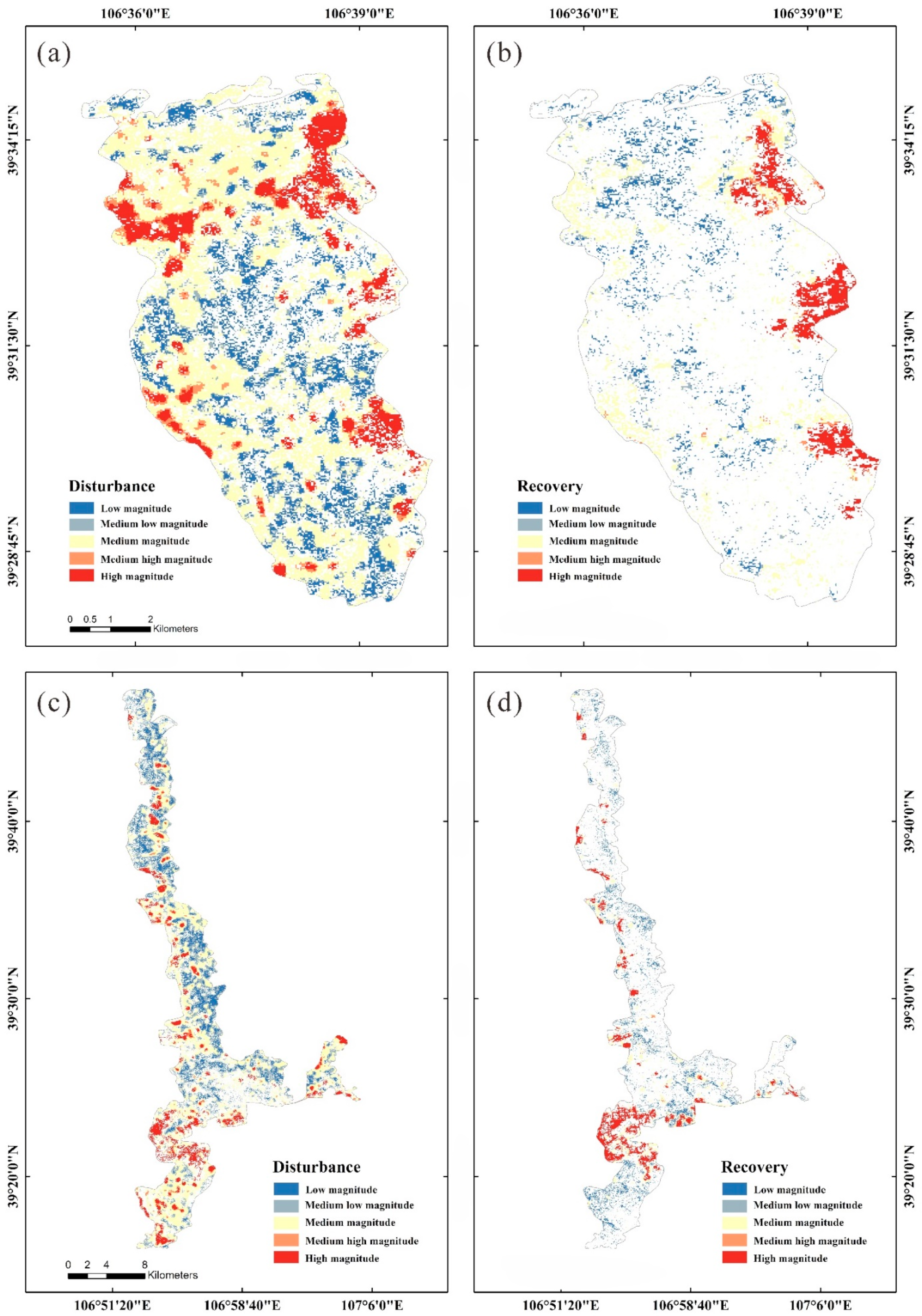
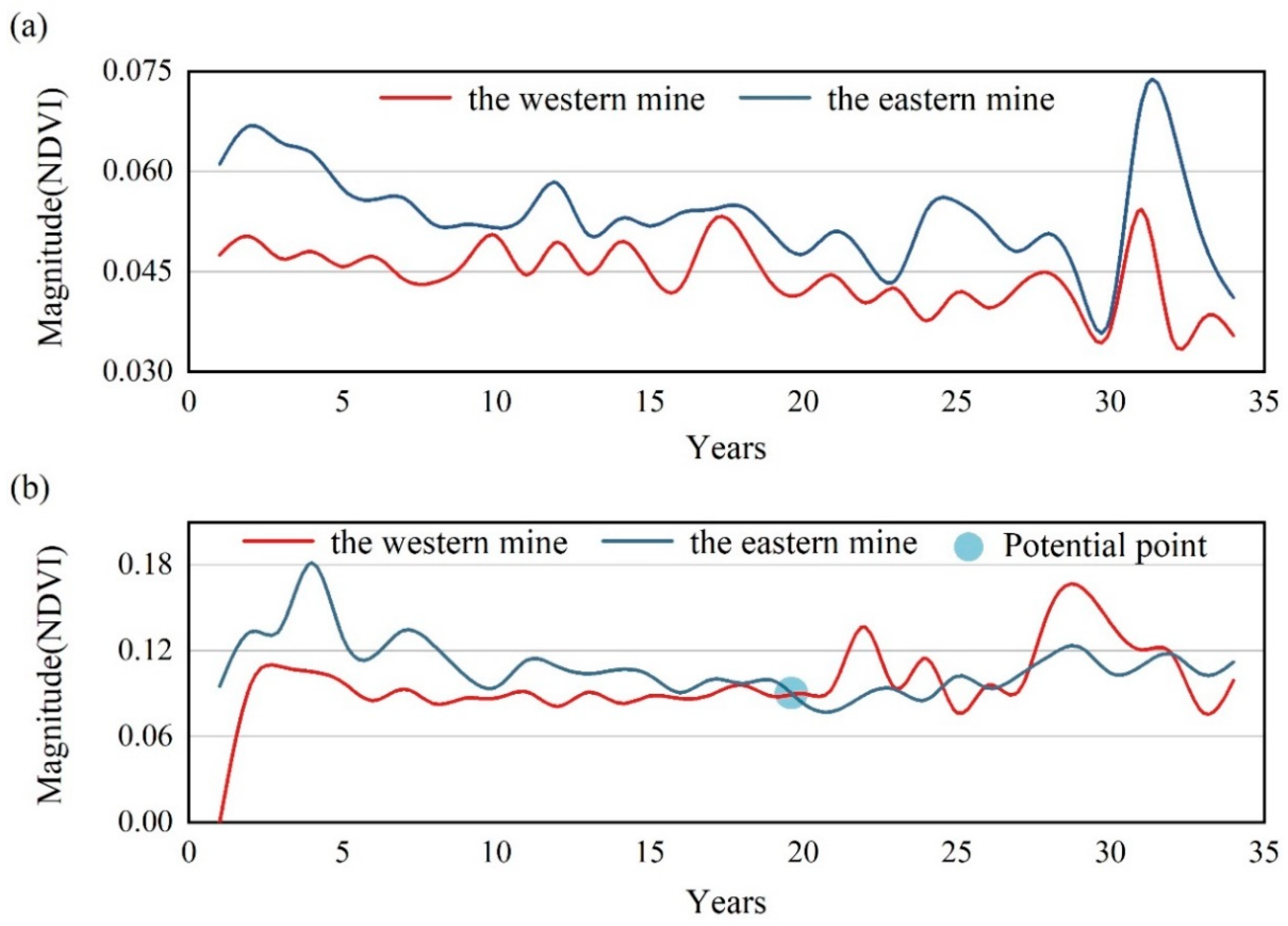
| NP | PD | LPI | LSI | AREA_MN | |
|---|---|---|---|---|---|
| The western mine | 3 | 0.0261 | 28.268 | 2.2047 | 1083.48 |
| The eastern mine | 61 | 0.0392 | 2.5438 | 14.2622 | 149.3705 |
| Disturbance | Recovery | |||||
|---|---|---|---|---|---|---|
| Year | Duration | Magnitude | Year | Duration | Magnitude | |
| The western mine | 1987–2020 | 1–34 | 0.021–0.438 | 1987–2019 | 2–34 | 0.061–0.610 |
| The eastern mine | 1987–2020 | 1–34 | 0.021–0.861 | 1987–2019 | 1–34 | 0.061–0.922 |
| Disturbance | Recovery | |||||
|---|---|---|---|---|---|---|
| Maximum | Mean | Standard Deviation | Maximum | Mean | Standard Deviation | |
| The western mine | 0.438 | 0.157 | 0.097 | 0.610 | 0.211 | 0.106 |
| The eastern mine | 0.861 | 0.304 | 0.177 | 0.922 | 0.367 | 0.183 |
| Disturbance | Recovery | |||
|---|---|---|---|---|
| The western mine | Duration | Duration | ||
| Magnitude | −0.218 ** | Magnitude | −0.004 | |
| The eastern mine | Duration | Duration | ||
| Magnitude | −0.243 ** | Magnitude | −0.163 ** | |
Publisher’s Note: MDPI stays neutral with regard to jurisdictional claims in published maps and institutional affiliations. |
© 2022 by the authors. Licensee MDPI, Basel, Switzerland. This article is an open access article distributed under the terms and conditions of the Creative Commons Attribution (CC BY) license (https://creativecommons.org/licenses/by/4.0/).
Share and Cite
Liu, Y.; Xie, M.; Liu, J.; Wang, H.; Chen, B. Vegetation Disturbance and Recovery Dynamics of Different Surface Mining Sites via the LandTrendr Algorithm: Case Study in Inner Mongolia, China. Land 2022, 11, 856. https://doi.org/10.3390/land11060856
Liu Y, Xie M, Liu J, Wang H, Chen B. Vegetation Disturbance and Recovery Dynamics of Different Surface Mining Sites via the LandTrendr Algorithm: Case Study in Inner Mongolia, China. Land. 2022; 11(6):856. https://doi.org/10.3390/land11060856
Chicago/Turabian StyleLiu, Yunxuan, Miaomiao Xie, Jinying Liu, Huihui Wang, and Bin Chen. 2022. "Vegetation Disturbance and Recovery Dynamics of Different Surface Mining Sites via the LandTrendr Algorithm: Case Study in Inner Mongolia, China" Land 11, no. 6: 856. https://doi.org/10.3390/land11060856
APA StyleLiu, Y., Xie, M., Liu, J., Wang, H., & Chen, B. (2022). Vegetation Disturbance and Recovery Dynamics of Different Surface Mining Sites via the LandTrendr Algorithm: Case Study in Inner Mongolia, China. Land, 11(6), 856. https://doi.org/10.3390/land11060856





